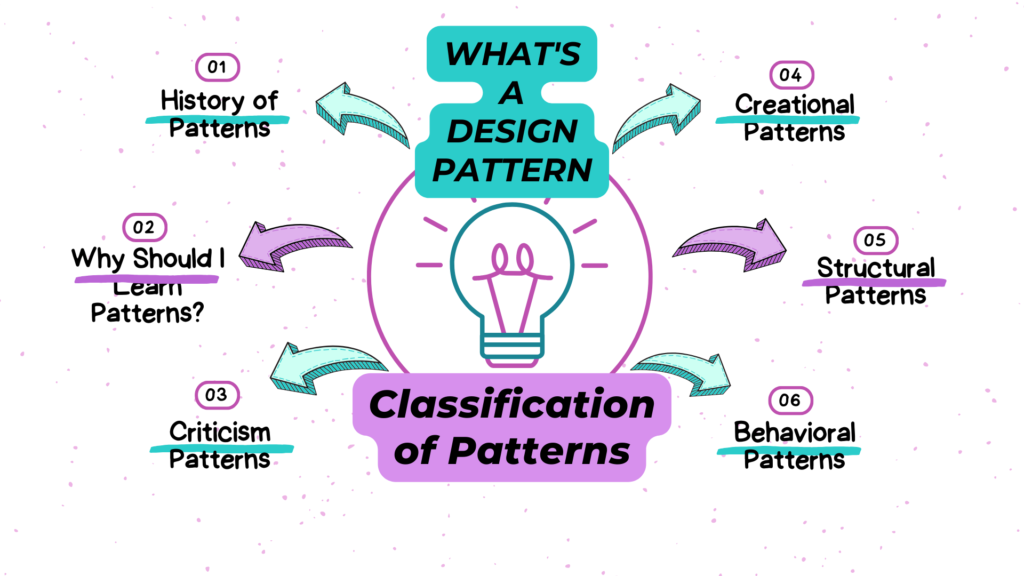Design patterns are foundational concepts in software development, serving as proven solutions to recurring design problems. They encapsulate best practices, promote code reusability, and enhance software maintainability. This article delves into the essence of designing patterns, their historical evolution, the significance of learning them, criticisms they face, and their classification.

Table of Contents
What’s a Design Pattern?
A designing pattern is a reusable solution to a common software design problem. It provides a template for solving specific issues that developers encounter during the design and implementation of software systems. Designing patterns are not code snippets but rather abstract solutions that can be applied across different projects and programming languages.
The Journey of Design Patterns: A Historical Perspective
The concept of designing patterns was popularized by the “Gang of Four” (GoF) in their seminal book “Design Patterns: Elements of Reusable Object-Oriented Software” published in 1994. The GoF identified 23 designing patterns categorized into three groups: creational, structural, and behavioral patterns. These patterns were derived from real-world solutions and best practices observed in software development community, marking a significant milestone in the evolution of software design methodologies.
Why Should I Learn Patterns?
The benefits of learning and incorporating design patterns into software development practices are manifold. Learning design patterns offers several advantages to software developers:
- Enhanced Reusability: Designing patterns promote code reuse, reducing redundancy and enhancing development efficiency.
- Scalability and Flexibility: They provide scalable solutions to design problems, enabling software systems to evolve and adapt to changing requirements.
- Improved Maintainability: By following established designing patterns, code becomes more understandable and easier to maintain over time, even as projects grow in complexity.
- Industry Standard: Designing patterns are widely accepted in the software industry, facilitating collaboration and communication among developers.
- Problem-Solving Skills: Understanding designing patterns hones developers’ problem-solving skills and encourages a structured approach to software design.
Criticism of Patterns
Despite their many advantages, designing patterns are not without their critics. Some common criticisms include:
- Potential for Overengineering: Over-reliance on designing patterns can lead to overly complex solutions for relatively simple problems, diminishing code simplicity and readability.
- Context Sensitivity: Designing patterns may not always fit perfectly into every context, requiring adaptation or customization.
- Learning Curve: Beginners and even experienced developers may find it challenging to grasp and effectively apply designing patterns, requiring dedicated learning and practice.
Classification of Patterns
Designing patterns are typically classified into three main categories, each addressing different aspects of software design and development:
- Creational Patterns: These patterns focus on object creation mechanisms, such as Singleton, Factory Method, and Builder patterns, streamlining the process of object instantiation and initialization.
- Structural Patterns: Structural patterns deal with object composition and class relationships, including Adapter, Decorator, and Proxy patterns, facilitating the design of flexible and modular systems.
- Behavioral Patterns: Behavioral patterns govern object interactions and communication, such as Observer, Strategy, and Command patterns, enhancing the flexibility and maintainability of software systems.
Here you can checkout our post on MVC design pattern with ASP.NET Core MVC
Conclusion
In conclusion, designing patterns play an important role in modern software development, offering a structured approach to problem-solving, offering reusable solutions, promoting code reusability, promoting best practices, fostering collaboration within the developer community and enhancing code quality. While they have their criticisms, understanding and applying designing patterns can significantly improve software design and development processes.
References
For more information and detailed references on the topics discussed in this article, please refer to the following links: